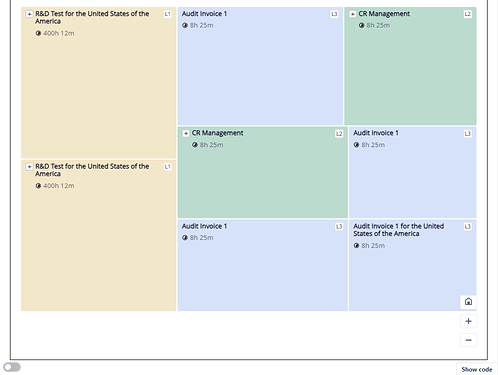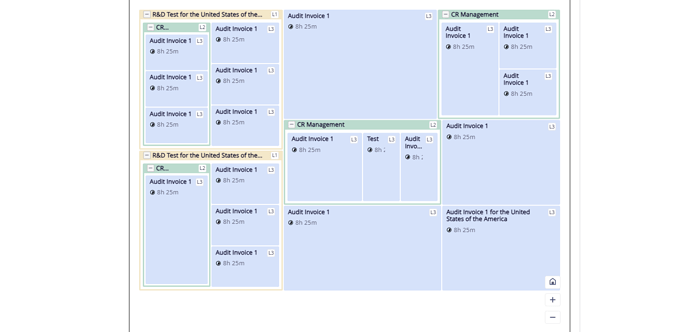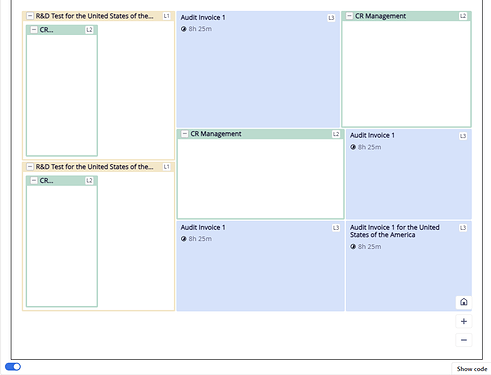That should be OK. I’ve modified the sample I gave you above with one that uses two different group templates, one with Group.isSubGraphExpanded true and the other false. The toggle button code now just changes the Part.category instead of the Group.isSubGraphExpanded property.
<!DOCTYPE html>
<head><body>
<script src="https://unpkg.com/gojs"></script>
<script src="https://unpkg.com/gojs/extensions/TreeMapLayout.js"></script>
<script id="code">
function init() {
if (window.goSamples) goSamples(); // init for these samples -- you don't need to call this
var $ = go.GraphObject.make; // for conciseness in defining templates
myDiagram =
new go.Diagram("myDiagramDiv", // must be the ID or reference to div
{
initialAutoScale: go.Diagram.Uniform,
"animationManager.isEnabled": false,
layout: $(TreeMapLayout, { isTopLevelHorizontal: false }),
allowMove: false, allowCopy: false, allowDelete: false
});
// change selection behavior to cycle up the chain of containing Groups
myDiagram.toolManager.clickSelectingTool.standardMouseSelect = function () { // method override requires function, not =>
var diagram = this.diagram;
if (diagram === null || !diagram.allowSelect) return;
var e = diagram.lastInput;
if (!(e.control || e.meta) && !e.shift) {
var part = diagram.findPartAt(e.documentPoint, false);
if (part !== null) {
var firstselected = null; // is this or any containing Group selected?
var node = part;
while (node !== null) {
if (node.isSelected) {
firstselected = node;
break;
} else {
node = node.containingGroup;
}
}
if (firstselected !== null) { // deselect this and select its containing Group
firstselected.isSelected = false;
var group = firstselected.containingGroup;
if (group !== null) group.isSelected = true;
return;
}
}
}
go.ClickSelectingTool.prototype.standardMouseSelect.call(this);
};
// Nodes and Groups are the absolute minimum template: no elements at all!
myDiagram.nodeTemplate =
$(go.Node,
{ background: "rgba(99,99,99,0.2)" },
new go.Binding("background", "fill"),
{
toolTip: $("ToolTip",
$(go.TextBlock, new go.Binding("text", "", tooltipString).ofObject())
)
}
);
myDiagram.groupTemplate =
$(go.Group, "Auto",
{ layout: null, isSubGraphExpanded: true },
{ background: "rgba(99,99,99,0.2)" },
new go.Binding("background", "fill"),
{
toolTip: $("ToolTip",
$(go.TextBlock, new go.Binding("text", "", tooltipString).ofObject())
)
}
);
myDiagram.groupTemplateMap.add("collapsed",
$(go.Group, "Auto",
{ layout: null, isSubGraphExpanded: false },
{ background: "rgba(99,99,99,0.2)" },
new go.Binding("background", "fill"),
{
toolTip: $("ToolTip",
$(go.TextBlock, new go.Binding("text", "", tooltipString).ofObject())
)
}
));
function tooltipString(part) {
if (part instanceof go.Adornment) part = part.adornedPart;
var msg = createPath(part);
msg += "\nsize: " + part.data.size;
if (part instanceof go.Group) {
var group = part;
msg += "\n# children: " + group.memberParts.count;
msg += "\nsubtotal size: " + group.data.total;
}
return msg;
}
function createPath(part) {
var parent = part.containingGroup;
return (parent !== null ? createPath(parent) + "/" : "") + part.data.text;
}
// generate a tree with the default values
rebuildGraph();
}
function rebuildGraph() {
var minNodes = document.getElementById("minNodes").value;
minNodes = parseInt(minNodes, 10);
var maxNodes = document.getElementById("maxNodes").value;
maxNodes = parseInt(maxNodes, 10);
var minChil = document.getElementById("minChil").value;
minChil = parseInt(minChil, 10);
var maxChil = document.getElementById("maxChil").value;
maxChil = parseInt(maxChil, 10);
// create and assign a new model
var model = new go.GraphLinksModel();
model.nodeGroupKeyProperty = "parent";
model.nodeDataArray = generateNodeData(minNodes, maxNodes, minChil, maxChil);
myDiagram.model = model;
myTreeDepthLimited = false;
}
// Creates a random number (between MIN and MAX) of randomly colored nodes.
function generateNodeData(minNodes, maxNodes, minChil, maxChil) {
var nodeArray = [];
if (minNodes === undefined || isNaN(minNodes) || minNodes < 1) minNodes = 1;
if (maxNodes === undefined || isNaN(maxNodes) || maxNodes < minNodes) maxNodes = minNodes;
// Create a bunch of node data
var numNodes = Math.floor(Math.random() * (maxNodes - minNodes + 1)) + minNodes;
for (var i = 0; i < numNodes; i++) {
var size = Math.random() * Math.random() * 10000; // non-uniform distribution
nodeArray.push({
key: i, // the unique identifier
isGroup: false, // many of these turn into groups, by code below
parent: undefined, // is set by code below that assigns children
text: i.toString(), // some text to be shown by the node template
fill: go.Brush.randomColor(), // a color to be shown by the node template
size: size,
total: -1 // use a negative value to indicate that the total for the group has not been computed
});
}
// Takes the random collection of node data and creates a random tree with them.
// Respects the minimum and maximum number of links from each node.
// The minimum can be disregarded if we run out of nodes to link to.
if (nodeArray.length > 1) {
if (minChil === undefined || isNaN(minChil) || minChil < 0) minChil = 0;
if (maxChil === undefined || isNaN(maxChil) || maxChil < minChil) maxChil = minChil;
// keep the Set of node data that do not yet have a parent
var available = new go.Set();
available.addAll(nodeArray);
for (var i = 0; i < nodeArray.length; i++) {
var parent = nodeArray[i];
available.remove(parent);
// assign some number of node data as children of this parent node data
var children = Math.floor(Math.random() * (maxChil - minChil + 1)) + minChil;
for (var j = 0; j < children; j++) {
var child = available.first();
if (child === null) break; // oops, ran out already
available.remove(child);
// have the child node data refer to the parent node data by its key
child.parent = parent.key;
if (!parent.isGroup) { // make sure PARENT is a group
parent.isGroup = true;
}
var par = parent;
while (par !== null) {
par.total += child.total; // sum up sizes of all children
if (par.parent !== undefined) {
par = nodeArray[par.parent];
} else {
break;
}
}
}
}
}
return nodeArray;
}
var myTreeDepthLimited = false;
function toggleDepth() {
myTreeDepthLimited = !myTreeDepthLimited;
const maxDepth = parseInt(document.getElementById("maxDepth").value);
myDiagram.commit(diag => {
myDiagram.nodes.each(grp => {
if (!(grp instanceof go.Group)) return;
const lev = grp.findSubGraphLevel(); // zero-based
if (lev !== maxDepth-1) return;
//grp.isSubGraphExpanded = myTreeDepthLimited ? false : true;
grp.category = myTreeDepthLimited ? "collapsed" : "";
});
});
}
window.addEventListener('DOMContentLoaded', init);
</script>
<div id="sample">
<div style="margin-bottom: 5px; padding: 5px; background-color: aliceblue">
<span style="display: inline-block; vertical-align: top; padding: 5px">
<b>New Tree</b><br />
MinNodes: <input type="number" width="2" id="minNodes" value="300" /><br />
MaxNodes: <input type="number" width="2" id="maxNodes" value="500" /><br />
MinChildren: <input type="number" width="2" id="minChil" value="2" /><br />
MaxChildren: <input type="number" width="2" id="maxChil" value="5" /><br />
MaxDepth: <input type="number" width="2" id="maxDepth" value="3" /><br />
<button type="button" onclick="rebuildGraph()">Generate Tree</button>
<button type="button" onclick="toggleDepth()">Toggle Tree Depth</button>
</span>
</div>
<div id="myDiagramDiv" style="background-color: white; border: solid 1px black; width: 100%; height: 500px"></div>
</div>
</body></head>


